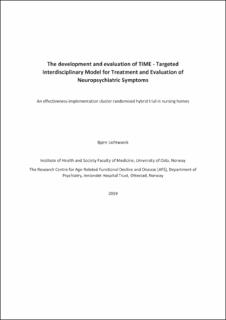| dc.contributor.author | Lichtwarck, Bjørn | |
| dc.coverage.spatial | Norway | en_US |
| dc.date.accessioned | 2020-09-23T12:10:03Z | |
| dc.date.available | 2020-09-23T12:10:03Z | |
| dc.date.issued | 2019 | |
| dc.identifier.isbn | 978-82-8377-419-1 | |
| dc.identifier.uri | https://hdl.handle.net/11250/2679283 | |
| dc.description.abstract | This thesis describes how the use of TIME, a multicomponent interdisciplinary approach, reduced agitation in residents with dementia living in nursing homes, with a possible reduction in other neuropsychiatric symptoms (NPS) and an improvement in quality of life. It emphasizes that since NPS often represent complex problems with multifactorial causes, multicomponent interventions should allow for adaption and flexibility to various settings to ensure successful implementation. Using TIME, the nursing home staff’s way of learning shifted from a traditional to a more innovative and reflection-based learning process. This seemed to make translating knowledge into action easier. One important causal assumption of the effectiveness of TIME was staff members’ development of a new, shared, and situated knowledge about each individual resident. This new knowledge was created through systematic interdisciplinary group reflection based on principles from cognitive behavioural therapy and led to person-centred treatment actions. | en_US |
| dc.language.iso | eng | en_US |
| dc.relation.haspart | Paper I: Lichtwarck, B., et al. "TIME – Targeted interdisciplinary model for evaluation and treatment of neuropsychiatric symptoms: protocol for an effectiveness-implementation cluster randomized hybrid trial". BMC Psychiatry, 2016, 16:233. The article is included in the thesis. Also available at: https://doi.org/10.1186/s12888-016-0944-0 | en_US |
| dc.relation.haspart | Paper II: Lichtwarck, B., et al. "Targeted Interdisciplinary Model for Evaluation and Treatment of Neuropsychiatric Symptoms: A Cluster Randomized Controlled Trial". The American Journal of Geriatric Psychiatry, 2018, 26(1), pp. 25-38. The paper is not available due to publisher restrictions. The published version is available at: https://doi.org/10.1016/j.jagp.2017.05.015 | en_US |
| dc.relation.haspart | Paper III: Lichtwarck, B., et al. "Experiences of nursing home staff using the targeted interdisciplinary model for evaluation and treatment of neuropsychiatric symptoms (TIME) – a qualitative study". Aging & Mental Health, 2019, 23(8), pp. 966-975. The paper is not available due to publisher restrictions. The published version is available at: https://doi.org/10.1080/13607863.2018.1464116 | en_US |
| dc.relation.haspart | Paper IV: Lichtwarck, B., et al. "TIME to reduce agitation in persons with dementia in nursing homes. A process evaluation of a complex intervention". BMC Health Services Research, 2019, 19:349. The paper is not available due to publisher restrictions. The published version is available at: https://doi.org/10.1186/s12913-019-4168-0 | en_US |
| dc.subject | Geriatric Psychiatry, | en_US |
| dc.subject | Doctoral thesis | en_US |
| dc.subject | Neuropsychiatric Symptoms | en_US |
| dc.subject | Nursing homes | en_US |
| dc.subject | Dementia | en_US |
| dc.title | The development and evaluation of TIME - Targeted Interdisciplinary Model for Treatment and Evaluation of Neuropsychiatric Symptoms: An effectiveness-implementation cluster randomised hybrid trial in nursing homes | en_US |
| dc.type | Doctoral thesis | en_US |
| dc.description.version | acceptedVersion | en_US |
| dc.rights.holder | ©Bjørn Lichtwarck, 2019.
All rights reserved. No part of this publication may be
reproduced or transmitted, in any form or by any means, without permission. | en_US |
| dc.source.pagenumber | 1-158 | en_US |
